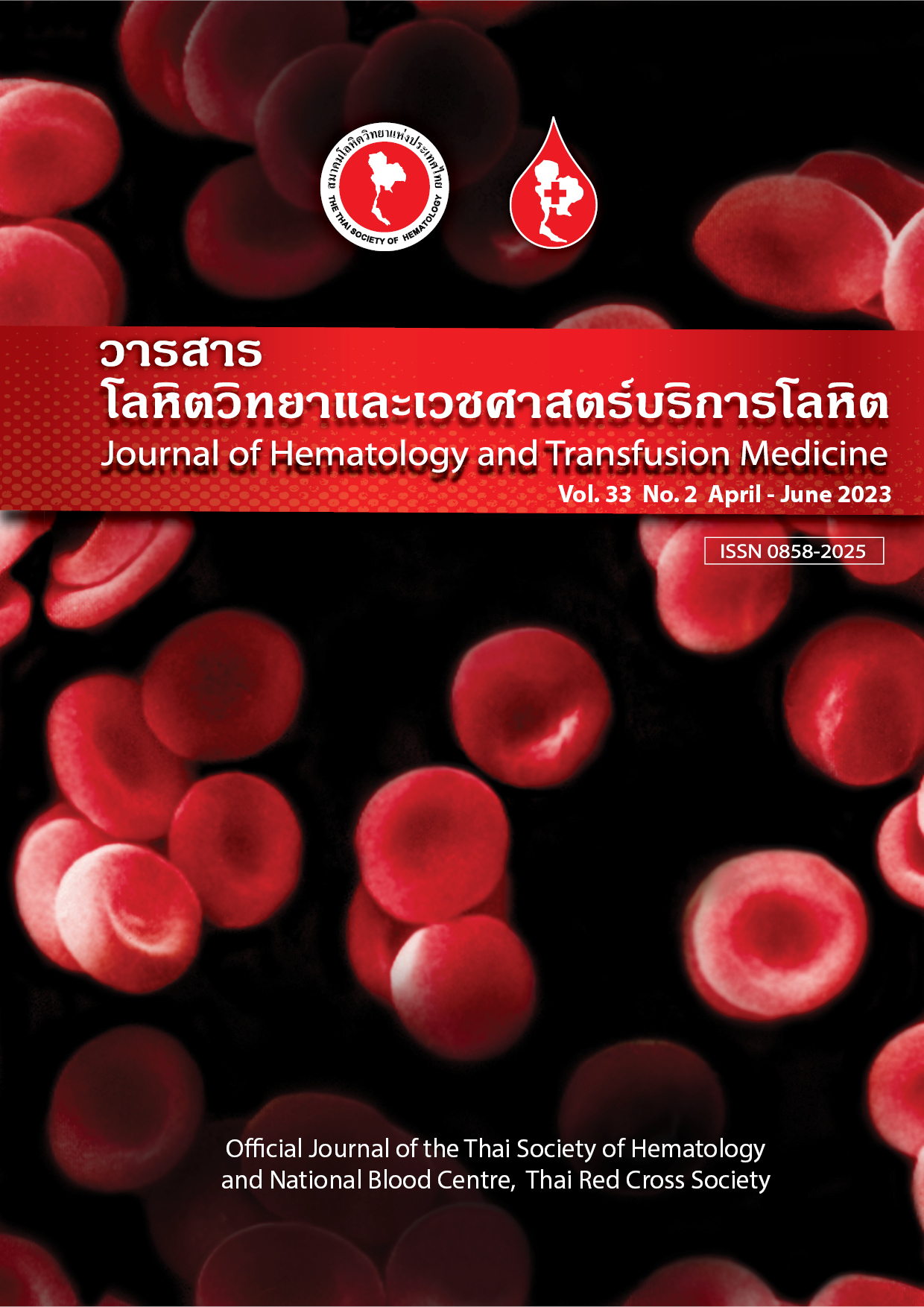การประเมินความถูกต้องของเครื่องตรวจวัดฮีโมโกลบินแบบพกพาสำหรับผู้บริจาคโลหิตที่มีระดับฮีโมโกลบินต่ำ
Keywords:
ฮีโมโกลบิน, ภาวะโลหิตจาง, ผู้บริจาคโลหิต, เครื่องตรวจวัดฮีโมโกลบินแบบพกพา, เครื่องตรวจวิเคราะห์เม็ดเลือดอัตโนมัติ, Hemoglobin, Anemia, Blood donor, Portable hemoglobinometer, Automated hematology analyzerAbstract
Abstract:
Introduction: Low hemoglobin (Hb) deferral among blood donors may result from the inaccuracy of screening devices. Objective: To assess the accuracy of Hb determination using two hemoglobinometers among deferred donors with low Hb levels. Materials and Methods: A total of 355 with low Hb levels were included in this study, comprised of individuals who were screened by either the HemoCue Hb 301 (n=178) or the CompoLab TM (n=177). Venous blood samples were taken and determined for Hb levels by an automated hematology analyzer (Sysmex XS-1000i), which was the reference method in this study. Results: The average Hb level among all study participants, as determined by the automated hematology analyzer, was 11.7± 0.9 g/dL. The average biases were approximately -0.01 g/dL for HemoCue Hb 301 and -0.34 g/dL for CompoLab TM. Statistical comparison of performance parameters between the two devices for screening anemia (i.e. Hb < 12 g/dL for female and < 13 g/dL for male) revealed no significant difference. Conclusion: In comparison with the automated analyzer, the average biases of HemoCue Hb 301 and CompoLab TM were within acceptable range, and the two devices provided comparable performance for screening anemia among the study participants.
บทคัดย่อ
บทนำ ผู้ที่ถูกเลื่อนการบริจาคโลหิตเนื่องจากการมีระดับฮีโมโกลบินต่ำอาจเป็นผลจากความคลาดเคลื่อนของเครื่องมือคัดกรอง วัตถุประสงค์ เพื่อประเมินความถูกต้องของการตรวจวัดระดับฮีโมโกลบินด้วยเครื่องตรวจวัดระดับฮีโมโกลบินแบบพกพาสองเครื่องในกลุ่มที่มีระดับฮีโมโกลบินไม่ผ่านเกณฑ์คัดเลือก วัสดุและวิธีการ กลุ่มประชากรศึกษา คือ ผู้บริจาคโลหิตที่ระดับฮีโมโกลบินต่ำกว่าเกณฑ์ จำนวน 355 ราย ซึ่งได้รับการตรวจด้วยเครื่อง HemoCue Hb 301 จำนวน 178 ราย และเครื่อง CompoLab TM จำนวน 177 ราย ทุกรายได้รับการเจาะเลือดจากหลอดเลือดดำนำไปตรวจด้วยเครื่องตรวจวิเคราะห์เม็ดเลือดอัตโนมัติ Sysmex XS-1000i ผลการศึกษา กลุ่มอาสาสมัครมีค่าเฉลี่ยระดับฮีโมโกลบินจากการตรวจด้วยเครื่องตรวจวิเคราะห์อัตโนมัติเท่ากับ 11.7± 0.9 g/dL เครื่อง HemoCue Hb 301 ให้ค่าเฉลี่ยความแตกต่าง (bias) เท่ากับ -0.01 g/dL ส่วนเครื่อง CompoLab TM ให้ค่าเฉลี่ยความแตกต่างเท่ากับ -0.34 g/dL และเมื่อเปรียบเทียบประสิทธิภาพของเครื่องมือแบบพกพาทั้งสองเครื่องในการคัดกรองภาวะโลหิตจาง (คือ ฮีโมโกลบินน้อยกว่า 12 g/dL ในเพศหญิง และน้อยกว่า 13 g/dL ในเพศชาย) พบว่า ให้ประสิทธิภาพแตกต่างกันอย่างไม่มีนัยสำคัญทางสถิติ (p > 0.05) สรุป เมื่อเปรียบเทียบกับเครื่องวิเคราะห์เม็ดเลือดอัตโนมัติ เครื่องตรวจวัดแบบพกพา HemoCue Hb 301 และ CompoLab TM ให้ค่าเฉลี่ยความแตกต่างกันในเกณฑ์ที่ยอมรับได้และมีประสิทธิภาพในการคัดกรองภาวะโลหิตจางในกลุ่มอาสาสมัครใกล้เคียงกัน
Downloads
References
Chaudhary R, Dubey A, Sonker A. Techniques used for the screening of hemoglobin levels in blood donors: current insights and future directions. J. Blood Med. 2017;8:75-88.
Chiewsilp P, Bejrachandra S, Bhakbhumpong T, editors. Blood donation manual.1st ed. Bangkok: Nam Akson Printing House; 2021.
Keating LJ, Gorman R, Moore R. Hemoglobin and hematocrit values of blood donors. Transfusion. 1967;7:420-4.
Pirofsky B, Nelson HM. The determination of hemoglobin in blood banks. Transfusion. 1964;4:45-9.
Sanchis-Gomar F, Cortell-Ballester J, Pareja-Galeano H, Banfi G, Lippi G. Hemoglobin point-of-care testing: the HemoCue system. J Lab Autom. 2013;18:198-205.
Yadav K, Kant S, Ramaswamy G, Ahamed F, Jacob OM, Vyas H, et al. Validation of point of care hemoglobin estimation among pregnant women using digital hemoglobinometers HemoCue 301 and HemoCue 201+) as compared with auto-analyzer. Indian J Hematol Blood Transfus. 2020;36:342–8.
Morris LD, Osei-Bimpong A, McKeown D, Roper D, Lewis SM. Evaluation of the utility of the HemoCue 301 haemoglobinometer for blood donor screening. Vox Sang. 2007;93:64-9.
Hinnouho G-M, Barffour MA, Wessells KR, Brown KH, Kounnavong S, Chanhthavong B, et al. Comparison of haemoglobin assessments by HemoCue and two automated haematology analysers in young Laotian children. J Clin Pathol. 2018;71:532-8.
Levy TS, Mendez-Gomez-Humaran I, Ruan MDCM, Tapia BM, Hernandez SV, Avila MH. Validation of Masimo Pronto 7 and HemoCue 201 for hemoglobin determination in children from 1 to 5 years of age. PLoS One. 2017;12: e0170990. doi: 10.1371/journalpone.0170990.
Daves M, Cemin R, Zagler EM, Joos A, Platzgummer S, Hueber R, et al. Evaluation of capillary haemoglobin determination for anaemia screening in blood donation settings. Blood Transfus. 2016;14:387-90.
WHO. Haemoglobin concentrations for the diagnosis of anaemia and assessment of severity. Vitamin and mineral nutrition information system. Geneva: World Health Organization; 2011. (WHO/NMH/NHD/MNM/11.1)
Anukul N, Sombatmai R, Leetrakool N, Somphan P. Evaluation of capillary hemoglobin measurement from portable hemoglobinometers in blood donor screening. J Hematol Transfus Med. 2018;28:121-9.
Butkun K, Loavanichkul P, Sriwanitchrak P, Jeumjanya N, Nathalang O. Evaluation of portable hemoglobinometers for hemoglobin screening in Thai blood donors. J Hematol Transfus Med. 2013;23:7-13.
Clinical laboratory improvement amendments of 1988 (CLIA); proficiency testing regulations related to analytes and acceptable performance. Federal register July 11, 2022:41194-242.
Tondon R, Verma A, Pandey P, Chaudhary R. Quality evaluation of four hemoglobin screening methods in a blood donor setting along with their comparative cost analysis in an Indian scenario. Asian J Transfus Sci. 2009;3:66–9.
Sümnig A, Hron G, Westphal A, Petersmann A, Kohlmann T, Greinacher A, et al. The impact of noninvasive, capillary, and venous haemoglobin screening on donor deferrals and the haemoglobin content of red blood cells concentrates: a prospective study. Transfusion. 2015;55:2847-54.
Rudolf-Oliveira RC, Gonçalves KT, Martignago ML, MengattoV, Gaspar PC, Ferreira JS, et al. Comparison between two portable hemoglobinometers and a reference method to verify the reliability of screening in blood donors. Transfus Apher Sci. 2013;49:578-82
Kittisares K, Permpikul P, Kittivorapart J, Siriboonrit U, Meesamat W, Vongpattaranon A, et al. Evaluation of hemoglobin screening methods in prospective blood donors by using hemoglobin photometers. J Hematol Transfus Med. 2015;25:307-12.
Ardin S, Störmer M, Radojska S, Oustianskaia L, Hahn M, Gathof BS. Comparison of three noninvasive methods for haemoglobin screening of blood donors. Transfusion. 2015;55:379-87.
Stevens GA, Paciorek CJ, Flores-Urrutia MC, Borghi E, Namaste S, Wirth JP, et al. National, regional, and global estimates of anaemia by severity in women and children for 2000–19: a pooled analysis of population-representative data. Lancet Glob Health. 2022;10:e627-39. doi: 10.1016/S2214-109X(22)00084-5.
Karami M, Chaleshgar M, Salari N, Akbari H, Mohammadi M. Global prevalence of anemia in pregnant women: a comprehensive systematic review and Meta-analysis. Matern Child Health J. 2022;26:1473-87.
Yadav K, Kant S, Ramaswamy G, Ahamed F, Vohra K. Digital hemoglobinometers as
point-of-care testing devices for hemoglobin estimation: a validation study from India. Indian J Community Med. 2020;45:506-10.
Downloads
Published
Issue
Section
License
Copyright (c) 2023 Journal of Hematology and Transfusion Medicine

This work is licensed under a Creative Commons Attribution-NonCommercial-NoDerivatives 4.0 International License.



